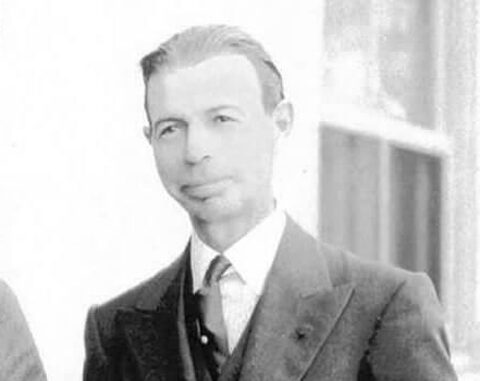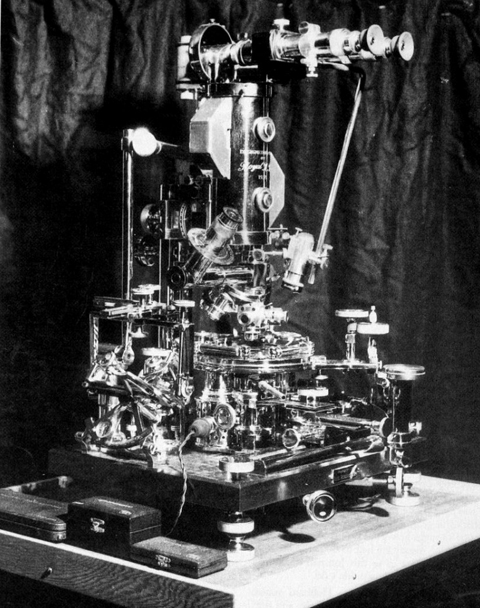
Even though he did not have a medical degree, scientific and medical journals referred to Royal Raymond Rife as “Dr. Rife.” Among such journals was the Annual Report of the Board of Regents of the Smithsonian Institution of 1944, which described major advances in the development of “The New Microscopes”. At the time, the breakthrough technology of using electron beams instead of light to visualize microscopic objects had opened up completely new windows of observation in biology and physics. Alongside the advanced electron microscope, however, Smithsonian authors Seidel and Winter reported on R.R. Rife’s “universal microscope” whose resolution and magnifying power exceeded even the new generation of electron microscopy.
The universal microscope was a mechanical marvel containing 5280 parts and 14 lenses and prisms that allowed for the live and in-motion observation of minute cellular structures and microorganisms hitherto invisible with the optical lens. Quoting from the Smithsonian report:
When the quartz prisms on the universal microscope, which may be rotated with vernier control through 360°, are rotated in opposite directions, they serve to bend the transmitted beams of light at variable angles of incidence while, at the same time, a spectrum is projected up into the axis of the microscope … [I]t is possible to proceed in this way from one end of the spectrum to the other, going all the way from the infrared to the ultraviolet.
Using polarization filters, Rife was able to observe microorganisms and viruses in vivo, and by the use of various prisms could produce “spectrograms” of each observed microorganism that are unique to the specimen.
Now, when that portion of the spectrum is reached in which both the organism and the color band vibrate in exact accord, one with the other, a definite characteristic spectrum is emitted by the organism. […]
A monochromatic beam of light, corresponding exactly to the frequency of the organism (for Dr. Rife has found that each disease organism responds to and has a definite and distinct wave length, a fact confirmed by British medical research workers) is then sent up through the specimen and the direct transmitted light, thus enabling the observer to view the organism stained in its true chemical color and revealing its own individual structure in a field which is brilliant with light.

This unique and individual resonance spectrum of each microorganism and pathogen—its electromagnetic signature—led the way to a new form of frequency therapy by identifying what Rife called the “mortal oscillation rate” of a selected germ. Just as the right resonance frequency of sound can break glass, Rife frequencies and their “coordinative resonance” will only destroy pathogens of exactly the same oscillation spectrum.
Rife’s inventions and curative achievements were reported even in the New York Times. In 1931, Dr. Milbank Johnson, professor of medicine at the University of Southern California (USC) in Los Angeles, and Dr. Arthur Kendall of Northwestern University in Chicago, a leading American bacteriologist, visited Rife’s San Diego laboratory to see the microscope and frequency treatment firsthand. Later that same year, forty-four of the most respected U.S. medical authorities gathered in Pasadena, California to honor Rife with a banquet announced as “The End to All Diseases.” In 1934, Dr. Johnson conducted a clinical trial using Royal Rife’s technique on 16 “terminally” ill cancer patients, presenting all 16 as “cured” only a few months later.
By 1938, several clinics that applied Rife frequency medicine had opened, and USC had organized a special medical research committee—headed by Dr. Johnson—to oversee Rife’s energy therapy and clinical success with various diseases such as tuberculosis, typhoid, other infectious diseases, and cancer.
However, by 1939, the American Medical Association, the American Cancer Society, and major pharmaceutical interest groups were stepping up with fury, denying and denouncing the efficacy of Rife’s techniques. At the same time, and for unknown reasons, a “mysterious” 3:00 A.M. fire destroyed the leading laboratory for electronic or energy medicine in New Jersey.
With the premature death in 1944 of Dr. Milbank Johnson, all the files relating to Rife vanished. Impoverished and denied access to medical-scientific laboratories, Royal Raymond Rife nevertheless began to develop his energy technologies anew, building various devices that came to be used for experiments and self-therapy. In 1960, the FDA and medical authorities invaded his laboratory and smashed and confiscated Rife’s frequency instruments, alleging that he had applied medical instrumentation without a license.
Royal Raymond Rife invented technologies that are still commonly used today in the fields of optics, electronics, radiochemistry, biochemistry, ballistics, and aviation, among them a heterodyning ultraviolet microscope, the very first micromanipulator, and a micro-dissector. He won 14 government awards for scientific discoveries.
Many believe that Royal Raymond Rife may have been the most brilliant, gifted, and undaunted scientist in American history.
Related:
“The New Microscopes” by R.E. Seidel and M. Elizabeth Winter in: Annual Report of the Board of Regents of the Smithsonian Institution 1944. See pages 207ff.
“Rife and His Microscopes” by Brian Bracegirdle in: Quekett Journal of Microscopy, 2003, 39, pp. 459-473.
Presentation by Steven Ross at the GlobalBEM Conference 2013
views: 19

